The New Line 18-07-1975
Exhibition of 15 years of work
Pieter Engels brings art, black humor and confusion to the public.
Museum Boymans van Beuningen, Rotterdam, is currently holding a retrospective of the work Pieter Engels (born: 1938; not in Hollywood USA, as he always states) created between 1960 and ’75. Those who are not so familiar with the hydrofoil mastermind of this artist will immediately think of a misunderstanding when they first walk around the exhibition. What we have here is a group exhibition of roughly twenty different views, techniques and backgrounds.
Even though the attendants, the title plates that accompany the works and the extensive catalog make it clear that this cacophony of artistic expressions really originated from the mind of one and the same Mr Engels, the idea of a group exhibition remains.
In retrospect, that is not such a bad thing at all.
Let’s just wrestle through this mishmash from the beginning (although here, too, there is a problem: the catalog begins with the work from ’74 and then runs back, to ’60. The earlier works may be paintings and drawings, but they are already so manifest, so anti-art that you can hardly build on them as a painter: they seem more like a closure, the bolt on the loft of painting. Canvases in a random way almost evenly smeared with smudges, lumps and slices of black, drab dull paint; image-less, illusion-less. Artful, anti-aesthetic paintings closely related to the Zero-art of the time (in our country a.o. Arrmando, Schoonhoven, Hendriks and Peeters).
These monochrome paintings, composed with paint, ashes , grit, a piece of mop, garbage, emerged until ín ’63; they have titles that already have something double-bottom-like ,, cancellation”, ,,dirty picture”,. Especially the last title which, together with the painting, clearly implies a piece of commentary on the art of painting, indicates what kind of ,, red line” will be followed in Engels’ further work.
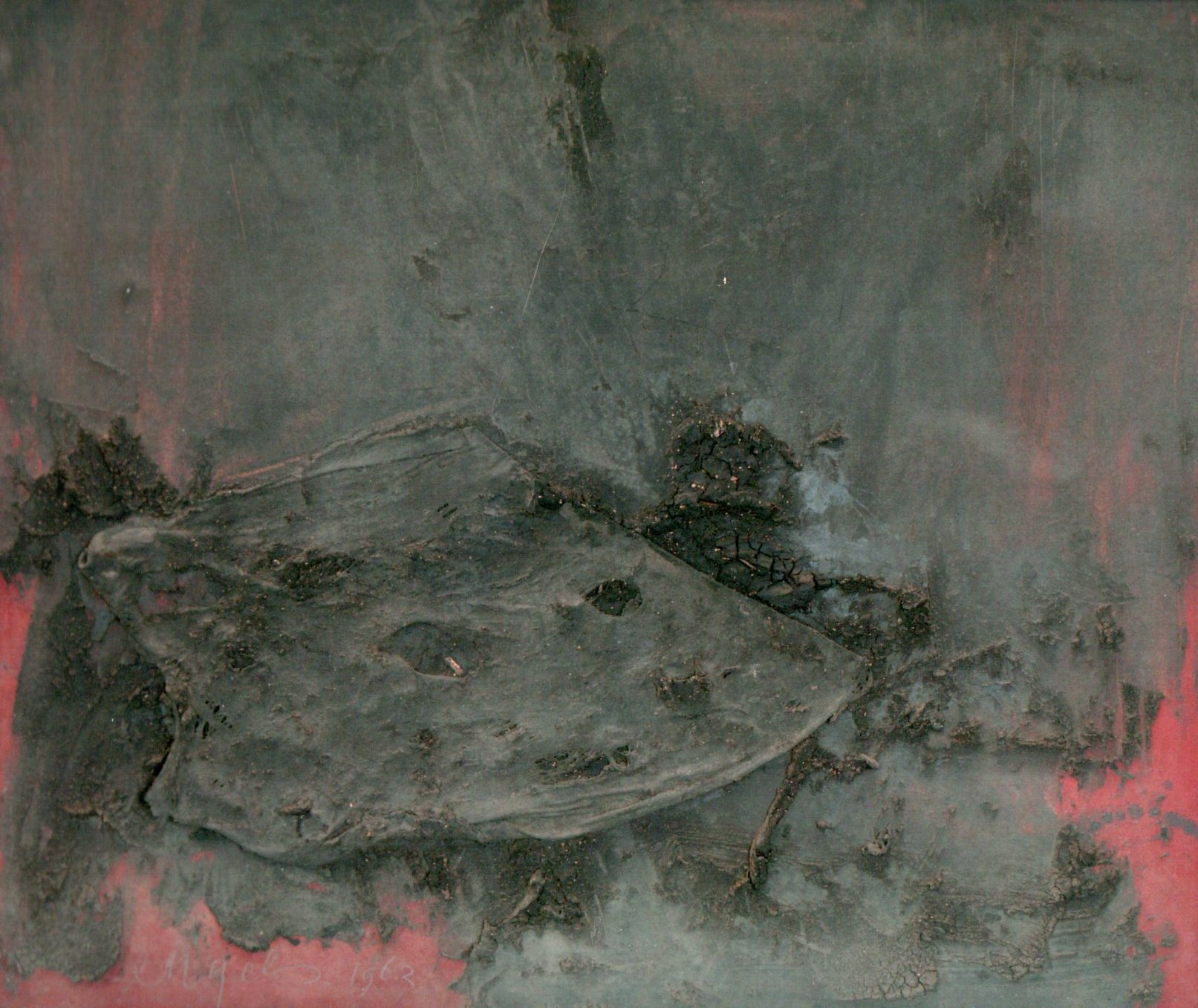
In ’63 Engels stopped painting (for the time being); from then on he started to manifest himself in the most diverse ways, with the application of the most diverse means – objects, happening-like campaigns and actions, advertisements, projects, spaces, showrooms, texts, all kinds of confusing situations, slogans, word spellings and slogans, sound and image recordings etc. etc. – manifest. This manifestation almost always has something of a commentary, parody, or hooking in; on phenomena and ideas that occur in contemporary society. In ’64, for example, he founded the “Engels Products Organization”(epo); the first in a series of increasingly complex names and objectives, institutes, which “director” Engels runs like a real manager; institutes that sell art, confusion, black humor, in short: Engels’ own dizzyingly comprehensive mental world. In ’64 this EPO displayed objects in “showrooms”: doors, chairs and other furniture that had been disassembled, cut to pieces and restored; but in such a way that they had become alienated, unusable and bizarre.
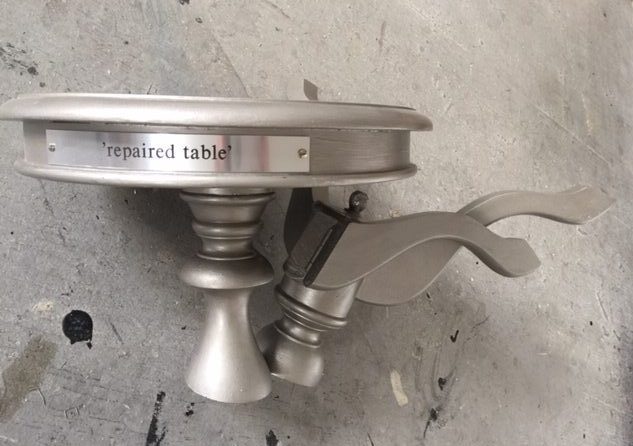
Your car damaged from f 25,-
One gets a good impression of Engels’ wide-ranging activities if one follows the enumeration from year to year in the Boymans catalog:
1965 – Engels institutes the EPO Culture Prize for plagiarism – begins writing an extensive philosophical work: “the new theory of relativity” a denial and undermining of reason, law and authority;
1966 – foundation “Engels Room” – showroom for Engels Products;
1967 – foundation “Engels New Internment Organization” ENIO ( new methods in the field of burial);
1968 – appears on the picture tube during a TV forum on self-portraiture in this century with a sheet over the head; develops “blackselly”(black vermicelli); develops “Paramarche shoes”( shoes with high soles and low heels).
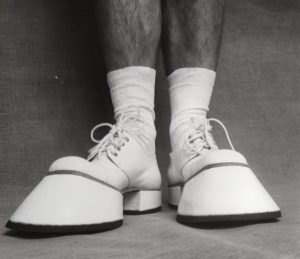
And so it goes on year after year. Since it is impossible within the scope of this article to go into the backgrounds, double entendres, etc. of all the Engels activities and works of art (where is the boundary in this case, by the way?), it seems better to me to take a few touches from the Rotterdam retrospective. These include, for example, a number of neatly designed, like real advertisements, “offers” from the EPO: You already have a Jaguar and a chinchilla for your wife and a private pool, air-conditioning throughout the house? Then now is the time to get EPA. Surprise your family! Your friends will envy you! You are so new to having EPA in your home!”. Then some handles from the catalog are listed: furniture, repaired furniture, ?, reliefs etc. ,, available in any color and material as well as bottles of air exhaled by Engels (f25,-p.st), bottles of Engels hair (limited stock,, f 20,-) or Engels’ tears (f 99,-). Other offers: a Wonder Event: Engels damages your car nicely for f 100,-; or Engels-Dag, an enjoyable day with drinks, complete with music, attractions and snacks; as a special attraction to speak with Engels, this also applies to you (f 5,- per minute; this also applies to the press), to dance with Engels and: objects brought along will be transformed on the spot by an intervention of Engels into Engels Product, f 25,- grab your chance! It is by no means just texts that Engels produces; the exhibition offers plenty of tangible objects from special Engels offerings, Obstacles, a kind of folding, extremely simply shaped room divider made of formica: blank formica panels in front of which a rail with a transparent plastic curtain is mounted; blank formica panels against which a ladies’ raincoat is mounted; folding panel montages on which text plates with typically meaningless dickish text are mounted (come on, make it”) etc. In 67′ Engels moves from these “last luxury” objects to something else again. He makes some large formica and plastic objects that reference painting.
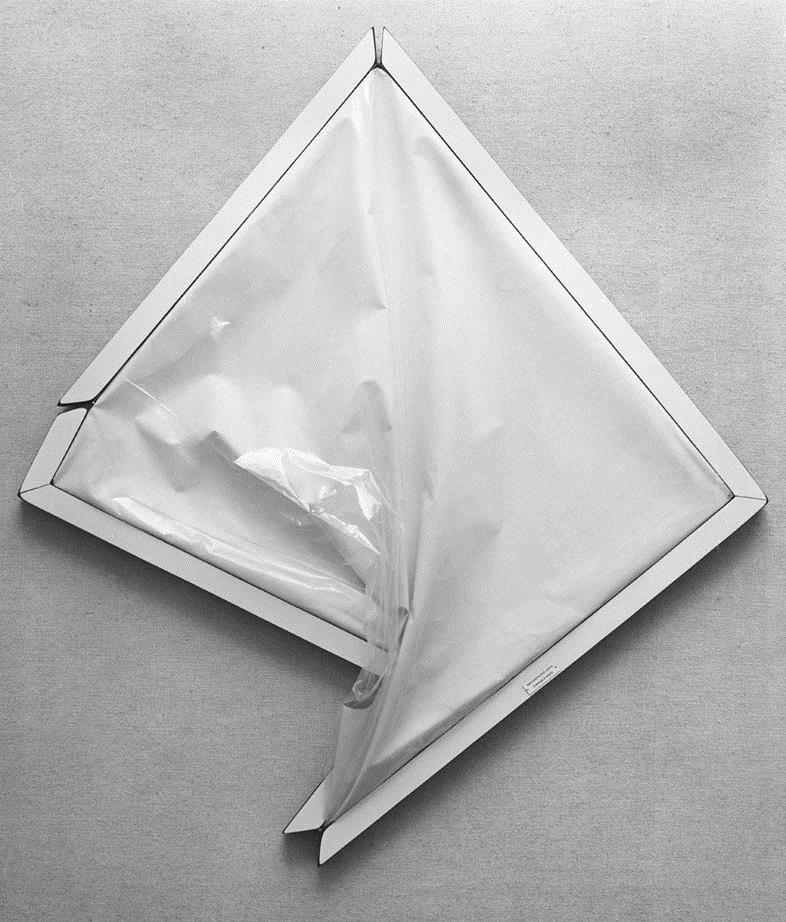
Bad Constructed Canvas 1967
Top piece from that period (Engels calls those different period, new collections”, they differ from each other mainly because they treat, comment on or parody a different theme) is Bad Constructed Canvas (hommage a Engels) from 1967: a large Formica frame that seems to be broken, in reality the havoc is neatly staged with the help of hinges.
The unpainted linen with plastic cover within this frame is torn and crumpled and in this capacity this piece of work is a highly dubious or better; intriguing object. A painting rendered in alienating materials (clean materials were at that time and still are for many artists the “opposites” of the materials considered old-fashioned linen, paint and stretched canvas), moreover in a serious condition and yet: a work of art executed with extreme precision and beautiful materials that through its size and well-considered simplicity is an almost monumental “portrait of a painting!
Idol and Mastermind
From the same year comes the satirical, but also very convincing as an independent monumental art object, “Modern art Piece ( the clothes of the emperor); an empty wooden frame, framed in flawless finished Formica with four rather illogical looking handles mounted in places. At the bottom of the frame is a small folding element on which two round aluminum discs are mounted. The title of the work only becomes visible after unfolding this element. Who is Engels making fun of with this work (with most of his works)? Modern art in general, his own work in particular, or does it not matter? Witness Engels’ many writings about Engels but also about art, the “impact” or quality of art, about society, about his goals in general or in particular is relativizing, that which concerns Engels most. It is no coincidence that he works so consistently on building his “image”; his emphatic presentation as an idol and mastermind is usually directly related to a parody of the artist’s phenomenon.
In many texts, Engels touches on the ludicrousness of the “new-er-the-newest” fads in art. His “Modern Art Piece is a direct paraphrase of the theorizing about contemporary art, but – yet another double bottom line – Engels continues to emphatically present all that he makes as very good exclusive art and in the process also disparages the viewer himself with endless, hard-to-read theories about his work, himself the art etc. and here we totally discern a wonderful squared figure: in my opinion, through all those texts and slogans he deliberately makes his visible visual art extra “difficult.”
,,(your) controversy: Pieter Engels”, the artist himself writes about this reversal of double entendres. He continues the characterization of his own situation with: “a controversy for the consumer (you) a controversy for the producer (Engels) (un)wanted Engels’ starting point: to cause a (dispute) conversation or (communication) or: the cudgel in the guardhouse. (This is also one of the threads that run through Engels’ entire oeuvre, the relativization and questioning of, among other things, the concept of quality). (Quality exists only by the grace of an agreement, and that agreement is grabbed out of thin air. Engels grabs his own agreements out of his own air)”. In general, visual artists who declare so much about their work do so to camouflage the fact that they are not clearly manifest enough in their visual work.
The remarkable thing about Engels, however, is that despite the many cult texts, explanations and bravura cries and other
explanations” he always arrives at art objects that speak for themselves. Building on the modern art series: he scoffs at the price of a “modern work of art”, a plain black perspex object that is virtually invisible has the following title plate: May 28, 1966 this work costs 4344 guilders, 1200 dollars, 502.97 English pounds or 4777 German marks; therefore it is a work of art. In other large black tombstone-like objects, the weight, dimensions, as well as the ashes of a burned modern work of art are discussed, among other things.
Absurdist reversal effects come into play in ’69 with sound tapes: two recorders are each at one end of a room. They each play a tape. ,, This sound was recorded by the tape recorder on the other side” reads the two devices.
Around ’70, the “negation projects” come into play. Using simple rectangular blocks and planes of black perspex, chains and pictures, Engels builds “spaces” for example for a complete dining area with table and chairs around it: what we see is actually a mark in the empty space of the place that the chairs and tables etc. would occupy if they were actually there.
Another common thread: denial and confirmation are close together in many projects or objects. Just like two other recurring concepts: creation and destruction, in different ways. The first paintings already have this double capacity, also the cutting of banknotes for f 10, also the damaging of the car for a fee, also those later suicide artworks (shoes in which one can stand to be electrocuted etc.)
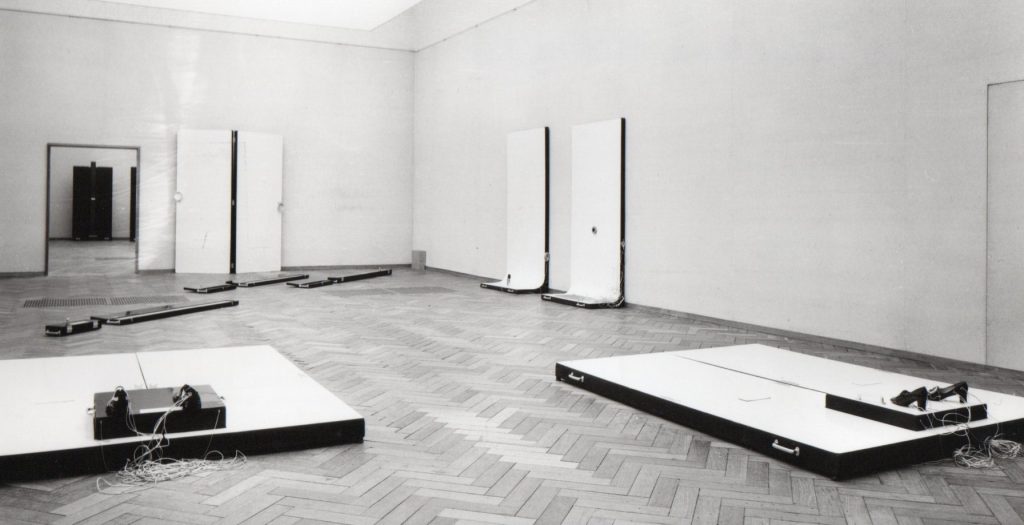
Or the curtain of steel chains that gives the passerby electric shocks (implemented in ’66). Yet another side of Engels; his situation plates”: uniform black perspex plates with simple inscriptions like: hang this plate near a floor”, … near a socket, ….. near a door, etc.
To make it all even more complicated, Engels stated in 69′ (“31 years Pieter Engels”) that he will antidate his subsequent work on ’51(13 years Pieter Engels), among other reasons because he “Theoretically will produce nothing more as he has already produced everything”.
Marga Klompé also had a difficult time with the artist. By letter he offered her to completely stop his art activities from March 1, ’71 until his death. This project “he visualized in a black board with neat text, a kind of proclamation, especially for the Kingdom of the Netherlands”. The purchase price was set at 25 million guilders.
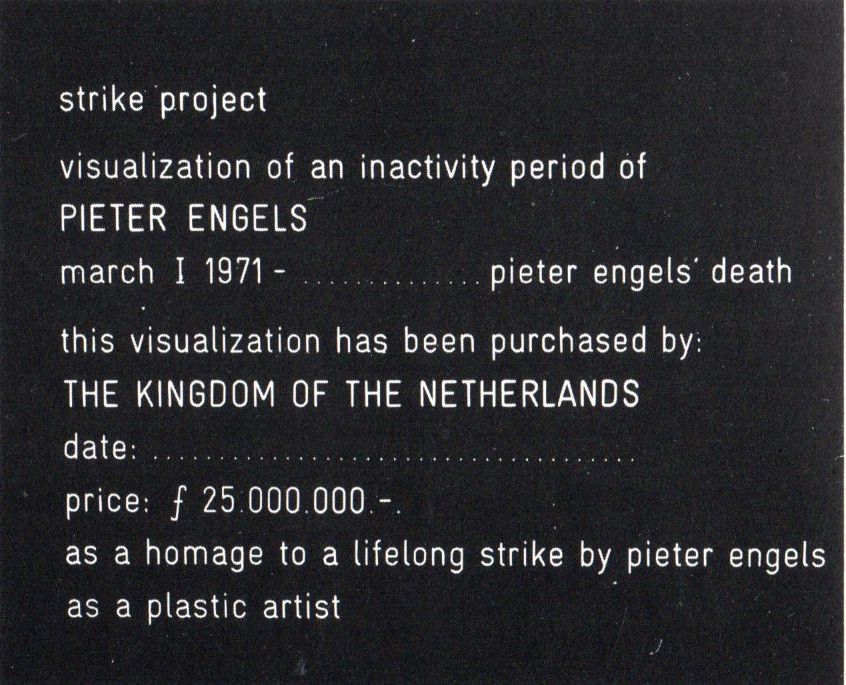
A ”narcistic-event” from ’72 is another one of those think-throughs, Engels is pictured with Stedelijk-Museum director Edy de Wilde, they are looking for a suitable empty place to hang this artwork (the photo enlarged and commented).
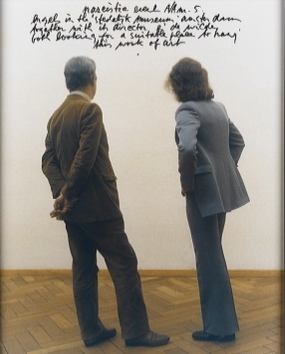
” In recent years, Engels has been mixing photos of himself while painting or sitting at the beach – four photos, the first three of which show Engels sitting on a chair; the last photo shows an empty chair. Text accompanying ,, The sea always moves … always(photo 2) ….always(3)…. So i moved(4) – with texts and comments, he creates in this way a fascinating far of concrete poetry; reality and idea become interwoven in a wonderful way.
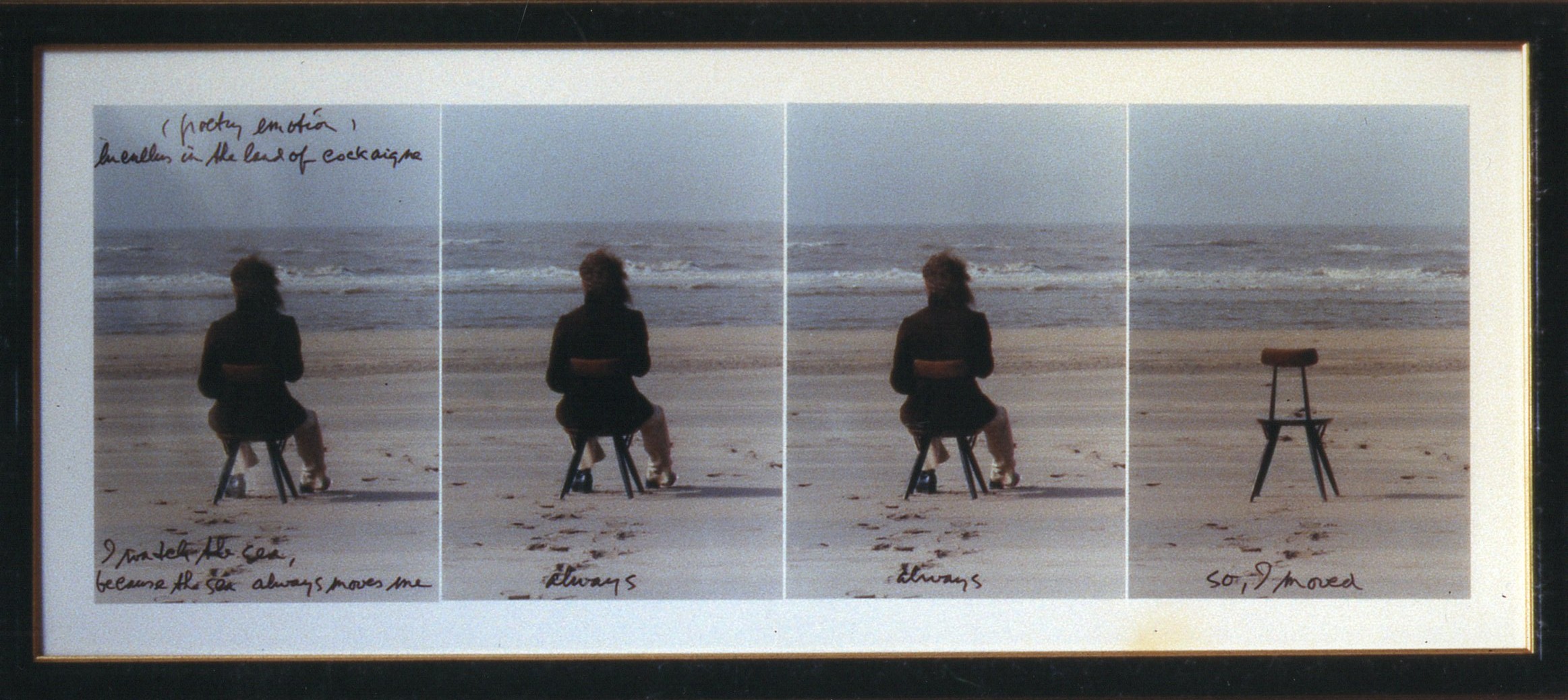
Other actions: painting a still life blindfolded, with a large black cloth draped over it as well, making paintings in a completely dark room performed under the flag of the “Genensis Foundation” founded by Engels in ’74.
This institute” also brought about that Engels started to work in a completely different “style” again. For him, the constant denial of his “own style” is a very essential feature of his work. He eschews repetition, rigidity, and therefore often scolds those artists who, for the sake of success in their art, continue to maintain a similar style. The survey follows Engels’ activities up to the last lightless paintings. But beyond the paintings and objects, there are the drawings, which often in addition to their aesthetically beautiful appearance (simple, drawn with a great sense of effect) already have a similar alienating content. ”Sadistic Event for a Lonely Tree” (’70), for example, shows a drawn tree being bombarded by two speakers set up diagonally to the side of the tree’s canopy.
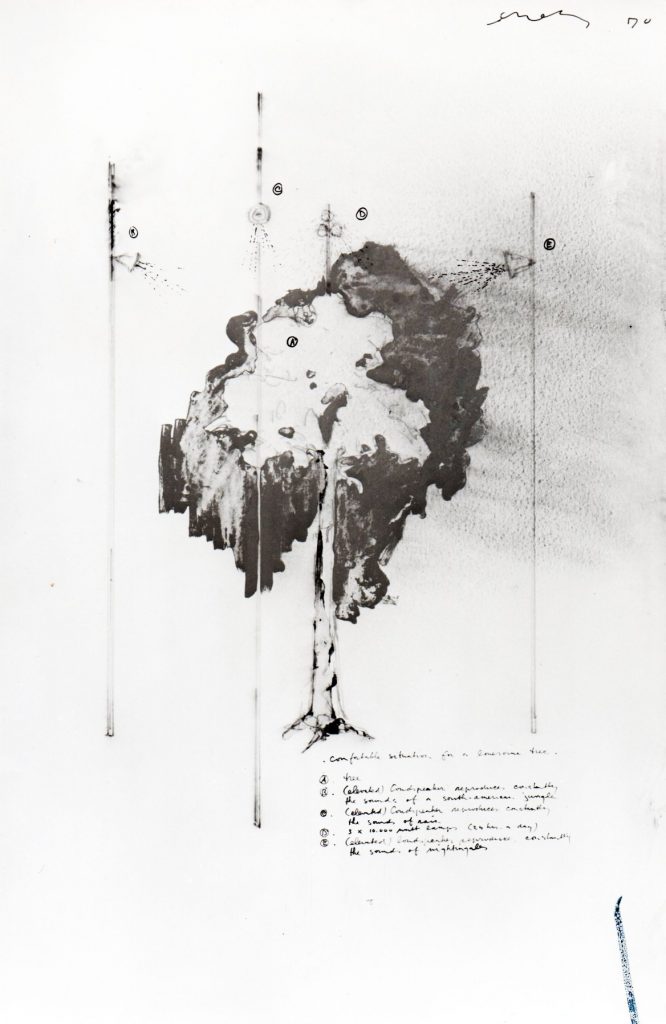
The notes to this sheet mention that these speakers constantly (24 hours a day” writes Engels; he never takes half measures), emit the sound of lumbering. So there are more brilliant examples, in which drawing, fiction, imagination and image are brought into contact with each other in a truly incomparable way. This, by the way, is also the great quality of Engels’ other work: what we see is poor, direct, simple, but precisely in these limitations it manages to suggest a great deal, to open up all kinds of possible worlds of thought.
Engels does too much to mention’.
In order to fully enjoy this art – Engels sees himself primarily as an entertainer, a stimulator of ideas, both for the public and for himself – some familiarity with art history is desirable, as well as a knowledge of the English language, because this artist wants his work to “speak” beyond the borders of the Netherlands. Finally, the typical quote from Engels’ many attempts to identify himself a little more closely to his public, here too he speaks, as if he were a true Messiah (and why not?) in the he-form: ,, My executive work is merely dosing. Causing an incident and his specialty is making the right choice for him. That makes him, among other things, an ideas man. He collects that data with which he wants to work and uses it to formulate a conclusion or an idea. At the same time he is aware that he could have come to a different conclusion by using other formulations and dosages – this satisfying his thesis (thesis he (you) have anyway): Engels formulation: ultimately the code consists of a succession of separate words: grouped together it forms, for example, a pornographic work”.
Thinking along these lines, one could say that starting from the concept of art – by now just as sacred and/or nonsensical, scary and/or incredibly vague, general and/or elitist as, e.g., “law book” – Engels continually creates taunts, paraphrases, posturing. That in itself makes it valuable enough. That in addition – or rather: first of all – he also makes clear, clearly concretized works of art in image or object is something that ( the incompleteness of this article will be felt even more clearly after looking at and experiencing Engels’ work) makes him particularly versatile.
”Engels does too much to mention”, he says to himself. He may well have the last word from me.
J.Juffermans